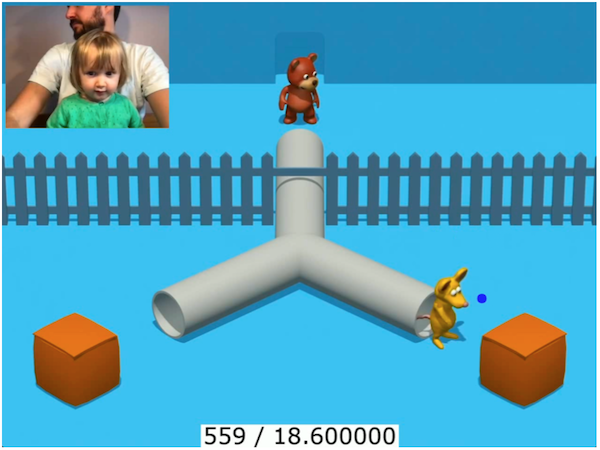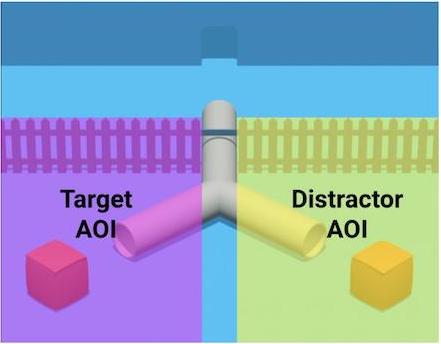
Project Overview
- Status: COMPLETE
- 16 participating labs collected data
- 125 toddlers tested remotely via webcam
- 33 authors on Infancy publication
In this multi-lab methodological project, we try to validate an open source, web-based, eye-tracking method for research on cognitive development in young children. More specifically, we evaluate whether this method, which is based on WebGazer.js (Papoutsaki et al., 2016) and jsPsych (de Leeuw, 2015), is comparable to lab-based eye-tracking.
Therefore, we aim to replicate findings of an in-lab paradigm of the ManyBabies2 project, which revealed spontaneous goal-directed action anticipation in toddlers using commercial eye-tracking systems (Schuwerk, Kampis et al., 2021).

A toddler participating in the task, with her point-of-gaze depicted as a blue dot

Example areas of interest (AOIs) used during the anticipatory period to distinguish looks to the "Target" region (where the chaser will reappear according to their action goal) and the "Distractor" region (covering the other tunnel exit and it's surroundings)
Links
- Notion site for contributors: check it out.
- Materials, Protocols, and Documentation: Google Drive.
- Pre-registration: OSF
- Listserv: join here or contact Tobias Schuwerk
- Slack: Please email any of the members of the leadership team to get a Join invitation
- News: MB-ManyWebcams news
Project Leads
- Adrian Steffan, Ludwig Maximilian University of Munich, Germany [email]
- Lucie Zimmer, Ludwig Maximilian University of Munich, Germany [email]
- Tobias Schuwerk, Ludwig Maximilian University of Munich, Germany [email]
MB-ManyWebcams Contributors
NOTE: Default table ordering is by contributor’s first name. You can filter, group, and/or sort entries by any field.
Publication
Steffan, A.*, Zimmer, L.*, Arias-Trejo, N., Bohn, M., Dal Ben, R., Flores-Coronado, M. A., Franchin, L., Garbisch, I., Grosse Wiesmann, C., Hamlin, J. K., Havron, N., Hay, J. F., Hermansen, T. K., Jakobsen, K. V., Kalinke, S., Ko, E.-S., Kulke, L., Mayor, J., Meristo, M., … Schuwerk, T. (2023). Validation of an open source, remote web-based eye-tracking method (WebGazer) for research in early childhood. Infancy. https://doi.org/10.1111/infa.12564 [PsyArXiv preprint] (*co-first authors)
to cite, use (Steffan & Zimmer et al., 2023)